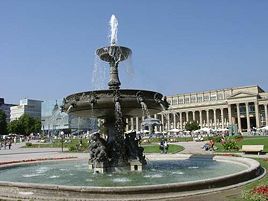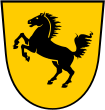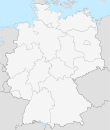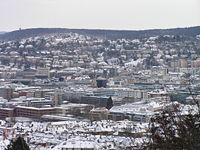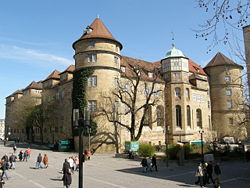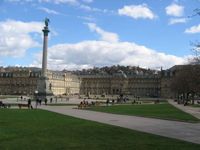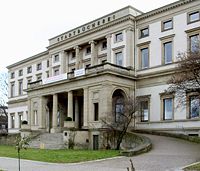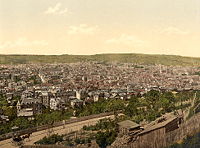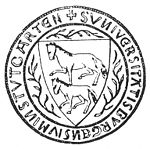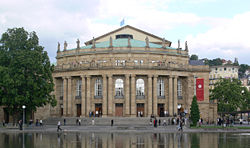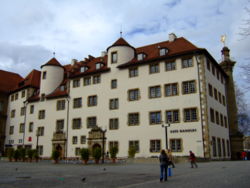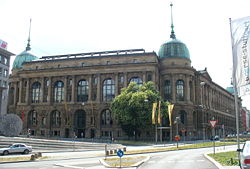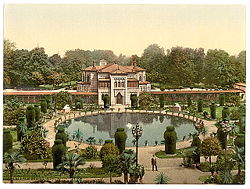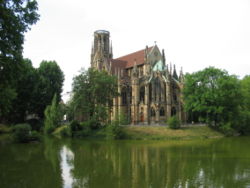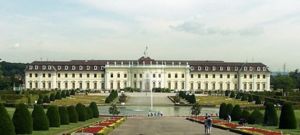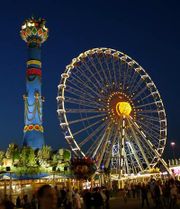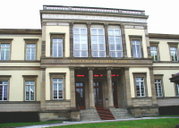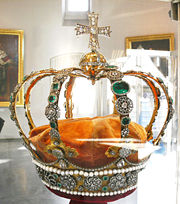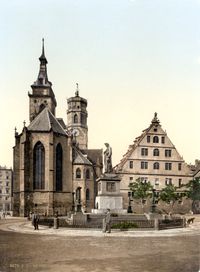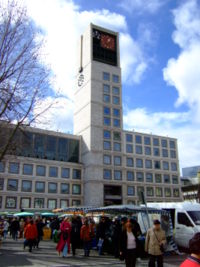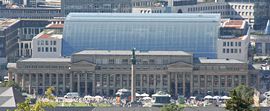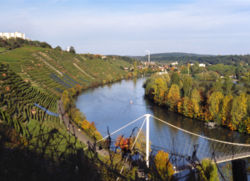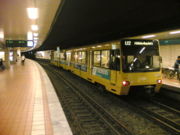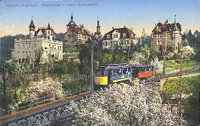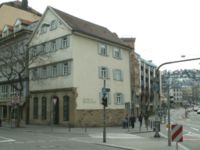Stuttgart
2008/9 Schools Wikipedia Selection. Related subjects: Europe; European Cities
| Stuttgart | |
| Stuttgart Schlossplatz (Castle square) | |
| Coat of arms | Location |
| Administration | |
| Country | Germany |
|---|---|
| State | Baden-Württemberg |
| Admin. region | Stuttgart |
| District | Urban district |
| City subdivisions | 23 districts |
| Lord Mayor | Wolfgang Schuster ( CDU) |
| Basic statistics | |
| Area | 207.36 km² (80.1 sq mi) |
| Elevation | 245 m (804 ft) |
| Population | 590,429 (29/02/2008) |
| - Density | 2,847 /km² (7,375 /sq mi) |
| Founded | 10th century |
| Other information | |
| Time zone | CET/ CEST ( UTC+1/ +2) |
| Licence plate | S |
| Postal codes | 70173–70619 |
| Area code | 0711 |
| Website | www.stuttgart.de Coordinates: |
Stuttgart (IPA: [ˈʃtʊtgaʁt]) is the capital of the state of Baden-Württemberg in southern Germany. The sixth-largest city in Germany, Stuttgart has a population of 590,429 (February 2008) while the metropolitan area referred to as Stuttgart Region has a population of 2.7 million ( 2007).
The city lies at the centre of a heavily populated area, circled by a ring of smaller towns. The inner urban area has a population of 2.63 million making 'greater Stuttgart' the third biggest city region in Germany after the Ruhr Area and Berlin.
Stuttgart is spread across a variety of hills, valleys and parks - unusual for German cities and often a cause of surprise to visitors who primarily associate the city with its industrial reputation as the " Cradle of the automobile".
Stuttgart has the status of Stadtkreis, a type of self-administrating urban county. It is also the seat of the regional parliament, local council and the Protestant State Church of Württemberg as well as one of the two co-seats of the bishop of the Roman Catholic diocese of Rottenburg-Stuttgart.
The city's motto is "Stuttgart is more" (to tourists; to business it describes itself as "Standort Zukunft", translated by town hall marketing as "Where business meets the future"). In 2007 the Bürgermeister marketed Stuttgart to foreign investors as "The creative power of Germany". Under current plans to improve transport links to the international infrastructure (as part of the Stuttgart 21 project), in March 2008 the city unveiled a new logo and slogan, describing itself as "Das neue Herz Europas" ("The new heart of Europe").
Stuttgart is nicknamed the Schwabenmetropole ( Swabian metropolis), a reference to the Swabian dialect spoken by the locals.
Geography
Stuttgart lies about an hour from the Black Forest and a similar distance from the Swabian Jura. The city centre lies in a lush valley, nestling between vineyards and thick woodland close to the River Neckar. In the hot summer months local residents refer to this area as the "Stuttgart cauldron".
Stuttgart covers an area of 207 square kilometres (80 sq mi). The elevation ranges from 207 metres above sea level by the Neckar river to 549 metres on Bernhartshöhe hill. As a result there are more than 400 flights of stairs around the city (called "Stäffele" in local dialect), equivalent to approximately 20 kilometres of steps. Many originate from the time when vineyards lined the entire valley. Even today there are vineyards less than 500 metres from the Main Station.
City districts
The city of Stuttgart is subdivided into a total of 23 city districts, 5 inner districts and 17 outer districts.
The inner districts are: Central Stuttgart, Stuttgart North, East, South and West.
The outer districts are:
- Bad Cannstatt (home to Western Europe's largest mineral spas/ Wilhelma zoo/the Stuttgart Spring Festival/ VfB Stuttgart football team)
- Degerloch ( The world's first television tower/ Stuttgarter Kickers football team)
- Möhringen (musical theatres)
- Stammheim (High-security court and jail - see RAF terrorists)
- Untertürkheim ( Daimler AG HQ and original Mercedes-Benz plant)
- Vaihingen, not to be confused with nearby Vaihingen (Enz) (one of two Stuttgart University campuses, headquarters of US armed forces in Europe)
- Zuffenhausen ( Porsche HQ)
- Feuerbach (Home of the original Bosch plant and Behr)
- as well as Birkach, Botnang, Hedelfingen, Mühlhausen, Münster, Obertürkheim, Plieningen, Sillenbuch, Stuttgart-Wangen and Weilimdorf.
Stuttgart's metropolitan area (the political entity " Stuttgart Region") encompasses the nearby towns of Ludwigsburg with its enormous baroque palace, Böblingen, Esslingen, Waiblingen, Göppingen and their respective districts.
Climate
Stuttgart has a continental climate. In the summer months, the nearby Black Forest and Swabian Alb hills act as a shield from severe weather but the city can also be subject to thunderstorms in the summer months and periods of snow lasting several days in the winter. The centre of the city, referred to by locals as the "Kessel" (cauldron) experiences more severe heat in the summer and less snow in the winter than the suburbs. Lying as it does at the centre of the European continent, the temperature range between day and night or summer and winter can be extreme. On average Stuttgart enjoys 1693 hours of sunshine per year.
Winters last from December to March. The coldest month is January with an average temperature of 0 °C (30 °F). Snow cover tends to last no longer than a few days although it has been known to last a couple of weeks as recently as 2004. The summers are warm with an average temperature of 20 °C (70 °F) in the hottest months of July and August. The summers last from May until September.
| Weather averages for Stuttgart, Germany | |||||||||||||
|---|---|---|---|---|---|---|---|---|---|---|---|---|---|
| Month | Jan | Feb | Mar | Apr | May | Jun | Jul | Aug | Sep | Oct | Nov | Dec | Year |
| Average high °C (°F) | 3 (37) | 4 (40) | 9 (49) | 12 (54) | 17 (63) | 20.5 (69) | 23 (73) | 23 (73) | 19 (66) | 14 (57) | 8 (46) | 4 (40) | 13 (56) |
| Average low °C (°F) | -3 (27) | -3 (27) | 0.5 (33) | 3 (37) | 7 (45) | 10.5 (51) | 13 (55) | 9 (49) | 8 (48) | 5 (41) | 0.5 (33) | -2 (29) | 4 (40) |
| Precipitation cm (inches) | 4.8 (1.9) | 4.6 (1.8) | 4.3 (1.7) | 6.1 (2.4) | 8.6 (3.4) | 8.6 (3.4) | 7.4 (2.9) | 8.4 (3.3) | 8.6 (3.4) | 5.8 (2.3) | 4.6 (1.8) | 4.6 (1.8) | 73.4 (28.9) |
| Source: Weatherbase Mar 2008 | |||||||||||||
History
Pre 19th century
The first known settlement of Stuttgart was around the end of the 1st century A.D. with the establishment of a Roman fort in the modern district of Cannstatt on the banks of the river Neckar. The Romans withdrew in around 260 A.D. following the invasion of the Alamanni from the north. Although nothing is known about Cannstatt during the period of Barbarian Invasion it is believed that the area remained inhabited as it is mentioned in Abbey of St. Gall archives dating back to 700 A.D.
Stuttgart itself was probably founded around 950 A.D. shortly before the Battle of Lechfeld by Duke Liudolf of Swabia, one of the sons of Holy Roman Emperor Otto I the Great. The town was used for breeding cavalry horses in fertile meadows at the very centre of today's city, although recent archaeological excavations indicate that this area was already home to Merovingian farmers.
A gift registry from Hirsau Abbey dated around 1160 mentioned "Hugo de Stuokarten", confirmation of the existence of the Stuttgart of today.
Between this time and the 14th century, the settlement was owned by the Margraves of Baden and the Württemberg towns of Backnang and Besigheim.
In around 1300 Stuttgart became the residence of the Counts of Württemberg who expanded the growing settlement into the capital of their territory ('Territorialstaat'). Stuttgart was elevated to the status of city in 1321 when it became the official royal residence. The territory around Stuttgart was known as the County of Württemberg before the counts were elevated to dukes by the Holy Roman Emperor in 1495 when Stuttgart became the Duchy capital and Ducal residence.
The name Württemberg originates from a steep hill in Stuttgart, formerly known as Wirtemberg.
In the 18th century, Stuttgart temporarily surrendered its residence status after Eberhard Ludwig founded Ludwigsburg to the north of the city. In 1775, Karl Eugen requested a return to Stuttgart, ordering the construction of the New Castle.
19th and 20th century
In 1803 Stuttgart was proclaimed capital of Württemberg Kurfürstentum (ruled by a Prince-elector) until Napoleon Bonaparte's breakup of the Holy Roman Empire in 1805 when Stuttgart became capital of the Kingdom of Württemberg. The royal residence was expanded under Frederick I of Württemberg although many of Stuttgart's most important buildings including the Wilhelm Palace, Katharina Hospital, the State Gallery, the Villa Berg and the Königsbau were built under the reign of King Wilhelm I.
Stuttgart's development as a city was impeded in the 19th century by its location. It was not until the opening of the Main Station in 1846 that the city underwent an economic revival. The population at the time was around 50,000.
During the revolution of 1848/1849, a democratic pan-German national parliament ( Frankfurt Parliament) was formed in Frankfurt to overcome the division of Germany. After long discussions, the parliament decided to offer the title of the German emperor to King Frederick William IV of Prussia. As the democratic movement became weaker, the German princes regained control of their independent states. Finally, the Prussian king declined the revolutionaries' offer. The members of parliament were driven out of Frankfurt and the most radical members (who wanted to establish a republic) fled to Stuttgart. A short while later, this rump parliament was dissolved by the Württemberg military.
By 1871 Stuttgart boasted 91,000 inhabitants and by the time Gottlieb Daimler invented the automobile in a small workshop in Cannstatt the population had risen rapidly to 176,000.
In 1871, as an autonomous kingdom, Württemberg joined the German Empire created by Otto von Bismarck, Prime Minister of Prussia, during the unification of Germany.
At the end of the First World War the monarchy broke down and the Free State of Württemberg was established, as a part of the Weimar Republic. Stuttgart was proclaimed the capital.
In 1920 Stuttgart became the seat of the German National Government (after the administration flee from Berlin, see Kapp Putsch).
Under Nazi Germany, Stuttgart began deportation of Jewish inhabitants in 1939. Around sixty percent of the German Jewish population had fled by the time restrictions on their movement were imposed on 1 October 1941 at which point Jews living in Württemberg were forced to live in "Jewish apartments" before being "concentrated" on the former Trade Fair grounds in Killesberg. On 1 December 1941 the first deportation trains were organised to Riga. Only 180 Jews from Württemberg held in concentration camps survived.
During World War II, the centre of Stuttgart was nearly completely destroyed due to Allied air raids. Some of the most severe bombing took place in 1944 at the hands of Anglo-American bombers. The heaviest raid took place on 12 September 1944 when the Royal Air Force bombed the old town of Stuttgarter dropping over 184,000 bombs including 75 blockbusters. More than 1000 people perished in the resulting firestorm. In total Stuttgart was subjected to 53 bombing raids, resulting in the destruction of 68% of all buildings and the death of 4477 people.
In 1945 the Allied Forces took control of Germany, spearheaded by the French army which occupied Stuttgart until the city fell into the American military occupation zone. An early concept of the Marshall Plan aimed at supporting reconstruction and economic/political recovery across Europe was presented during a speech given by US Secretary of State James F. Byrnes at the Stuttgart Opera House. His speech led directly to the unification of the British and American occupation zones, resulting in the 'bi-zone' (later the 'tri-zone' including the French). When the Federal Republic of Germany was founded on 7 October 1949, Stuttgart, like Frankfurt, was a serious contender to become the federal capital, but finally Bonn succeeded.
Parts of the former German States of Baden and Württemberg were merged in 1952 leading to founding of the new state of Baden-Württemberg, now Germany's third largest state.
Recent
During the Cold War, Stuttgart became home to the joint command centre of all United States military forces in Europe, Africa and the Atlantic (US European Command, EUCOM). EUCOM is still headquartered there today. U.S. Army bases in and around Stuttgart include or included the following: Patch Barracks (HQ EUCOM), Robinson Barracks, Panzer Kaserne, Kelley Barracks.
In the late 1970s, the district of Stammheim was centre stage of one of the most controversial periods of German post-war history during the trial of Red Army Faction members at Stammheim high-security court. After the trial, Ulrike Meinhof, Andreas Baader, Gudrun Ensslin and Jan-Carl Raspe committed suicide in Stammheim. Several attempts were made to free the terrorists by force or blackmail during the ' German Autumn' of 1977, culminating in the abduction and murder of the German industrialist and President of the German Employers' Association Hanns Martin Schleyer as well as the hijacking of Lufthansa flight LH181.
In 1978 Stuttgart's suburban railway came into operation.
Origin of the city's name and its coat of arms
Stuttgart's coat of arms shows a black horse on its hind legs on a yellow background. It was first used in its current format in 1938 before when various designs and colours had been used, often with two horses. The canting seal pictured here reflects the origin of the name "Stuttgart". The name in Old High German was "stuotgarten", with "stuot" cognate with the Old English term "stod" (Modern English: "stud", relating to the breeding of horses). The Old High German term "garten" referred to the compound on the site of the original settlement.
Landmarks, sights and culture
The inner city
At the centre of Stuttgart lies its main square, Schlossplatz. As well as being the largest square in Stuttgart, it stands at the crossover point between the city's shopping area, Schlossgarten park which runs down to the river Neckar, Stuttgart's two central castles and major museums and residential areas to the south west.
Although the city centre was heavily damaged during World War II, many historic buildings have been reconstructed and the city boasts some fine pieces of modern post-war architecture. Buildings and squares of note in the inner city include:
- The Stiftskirche (the Collegiate Church), 1200 - 1600. Exterior: Romanesque/ Gothic; interior: Romanesque/Gothic/Modern. Reconstructed with simplified interior
- Altes Schloss (the Old Castle), 1300 - 1500. Renaissance style; reconstructed
- Alte Kanzlei (the Old Chancellery) on Schillerplatz which backs onto the 1598 Mercury Pillar
- Neues Schloss (the New Castle), 1700 - 1800. Baroque/ Classicism); reconstructed with modern interior
- Wilhelmpalais (the King Wilhelm Palais), 1840
- Königsbau (the King's Building), 1850. Classicism; reconstructed
- The Großes Haus of Stuttgart National Theatre, 1909-1912
- Markthalle Market Hall, 1910. (Art Nouveau)
- The Hauptbahnhof (Main Railway Station), 1920. Pre-Modern
- The Württembergische Landesbibliothek state library, rebuilt in 1970.
- Friedrichsbau Varieté (Friedrich Building), rebuilt in 1994 on the site of the former art nouveau building
Architecture in other districts
A number of significant castles stand in Stuttgart's suburbs and beyond as reminders of the city's royal past. These include:
- Castle Solitude, 1700 - 1800. Baroque/Rococo)
- Ludwigsburg Palace, 1704 - 1758. Baroque, with its enormous baroque garden.
- Castle Hohenheim, 1771 - 1793
Other landmarks in and around Stuttgart include (see also museums below):
- Castle Rosenstein (1822-1830). Classical
- Württemberg Mausoleum (1824) which holds the remains of Catherine Pavlovna of Russia and King William I of Württemberg
- Wilhelma Zoo and Botanical Gardens (1853)
- Weissenhof Estate (1927), ( International Style)
- The TV Tower (1950), the world's first concrete TV tower
- Stuttgart Airport Terminal Building, 2000. In neighbouring Leinfelden-Echterdingen
Parks, lakes, cemeteries and other places of interest
At the centre of Stuttgart lies a series of gardens referred to by locals as the Green U and popular with families and cyclists. It starts with the old Schlossgarten, castle gardens first mentioned in records in 1350. The modern park stretches down to the river Neckar and is divided into the upper garden (bordering the Old Castle, the Main Station, the State Theatre and the State Parliament building), and the middle and lower gardens - a total of 61 hectares. The park also houses Stuttgart planetarium.
At the far end of Schlossgarten lies the second Green U park, the larger Rosensteinpark which borders Stuttgart's Wilhelma zoo and botanical gardens. Planted by King William I of Württemberg, it contains many old trees and open areas and counts as the largest English-style garden in southern Germany. In the grounds of the park stands the former Rosenstein castle, now the Rosenstein museum.
Beyond bridges over an adjacent main road lies the final Green U park, Killesbergpark or 'Höhenpark' which is a former quarry that was converted for the Third Reich garden show of 1939 (and was used as a collection point for Jews awaiting transportation to concentration camps). The park has been used to stage many gardening shows since the 1950s, including the Bundesgartenschau and 1993 International Gardening Show, and runs miniatures trains all around the park in the summer months for children and adults. The viewing tower (Killesbergturm) offers unique views across to the north east of Stuttgart.
On the northern edge of the Rosensteinpark is the famous " Wilhelma", Germany's only combined zoological and botanical garden. The whole compound, with its ornate pavilions, greenhouses, walls and gardens was built around 1850 as a summer palace in moorish style for King Wilhelm I of Württemberg. It currently houses around 8000 animals and some 5000 plant species and contains the biggest magnolia grove in Europe.
Other parks in Stuttgart include the gardens at Castle Hohenheim (which date back to 1776 and are still used to catalogue and research plant species), Uhlandshöhe hill (between the city centre, Bad Cannstatt and Frauenkopf, and home to Stuttgart observatory), the Weißenburgpark (a five hectare park in the Bopser area of Stuttgart South which dates back to 1834 and is now home to a 'tea house' and the 'marble room' and offers a relaxing view across the city centre), the Birkenkopf (at 511 metres the highest point in central Stuttgart, where many ruins were laid to commemorate the Second World War), the Eichenhain park in Sillenbuch (declared a nature reserve in 1958 and home to 200 oak trees, many 300-400 years old).
There are number of natural and artificial lakes and ponds in Stuttgart. The largest is the Max-Eyth-See which was created in 1935 by reclaiming a former quarry and is now an official nature reserve. It is surrounded by an expansive open area overlooked by vineyards on the banks of the river Neckar near Mühlhausen).
There are expansive areas of woodland to the west and south west of Stuttgart which are popular with walkers, families, cyclists and ramblers. The most frequented lakes form a 3km trio made up of the Bärensee, Neuer See and Pfaffensee. The lakes are also used for local water supplies.
In the Feuersee area in the west of Stuttgart lies one of two "Feuersee"s (literally fire lakes), striking for its views of the church across the lake, surrounded by nearby houses and offices. The other Feuersee can be found in Vaihingen.
Cemeteries in Stuttgart include:
- The Hoppenlaufriedhof in Central Stuttgart, the oldest remaining cemetery which dates back to 1626, an infirmary graveyard that last used in 1951
- The Waldfriedhof, the 1913 forest cemetry that is connected to Südheimer Platz by funicular railway
- The Pragfriedhof, with its Art Nouveau crematorium. Established in 1873 it was extended to include Jewish graves in 1874 and also now houses the Russian orthodox Church of Alexander Nevsky
- The Uff-Kirchhof cemetry in Bad Cannstatt which stands at the crossroads of two ancient Roman roads and Cannstatter Hauptfriedhof, the largest graveyard in Stuttgart which has been used as a Muslim burial ground since 1985.
The districts of Bad Cannstatt and Berg are home to the second largest mineral spas in Europe (only surpassed by the baths of Budapest).
Culture and events
Stuttgart is known for its strong cultural heritage, in particular its State Theatre (Staatstheater) and State Gallery (Staatsgallerie). The Staatstheater is home to the State opera and three smaller theatres and it regularly stages opera, ballet and theatre productions as well as concerts. The Staatstheater was named Germany/Austria/Switzerland "Theatre of the year" in 2006; Stuttgart Opera has won the "Opera of the year" award six times. Stuttgart Ballet is connected to names like John Cranko and Marcia Haydée.
The city also offers two broadway-style musical theatres, the Apollo and the Palladium Theatre (each approx. 1800 seats). Ludwigsburg Palace in the nearby town of Ludwigsburg is also used throughout the year as a venue for concerts and cultural events.
The Schleyerhalle sports arena is regularly used to stage rock and pop concerts with major international stars on European tour.
Stuttgart's Swabian cuisine, beer and wine have been produced in the area since the 1600s and are now famous throughout Germany and beyond. For example, Gaisburger Marsch is a stew that was invented in Stuttgart's Gaisburg area of Stuttgart South.
In 1993 Stuttgart hosted the International Garden Show in the suburb of Killesberg. In 2006 it was also one of the host cities of the Football World Cup. The city is set to host the 2008 World Individual Debating and Public Speaking Championships.
Regular events that take place in Stuttgart:
- The world-famous annual "Volksfest", originally a traditional agricultural fair which now also hosts beer tents and a French village and is second in size only to the Oktoberfest in Munich. Unlike Munich, however, there is also a Spring festival on the same grounds in April of each year.
- With more than 3.6 million visitors in 2007 and more than 200 stands, Stuttgart's Christmas Market is the largest and one of the oldest and most beautiful traditional Christmas markets in Europe. It is especially renowned for its abundant decorations and takes place in the 4 weeks leading up to Christmas.
- The Fish Market (Hamburger Fischmarkt, late July) with fresh fish, other food and beer from Hamburg
- The Summer Festival (Stuttgart Sommerfest, usually in early August) with shows, music, children's entertainment and local cuisine in Schlossplatz, Stuttgart and adjacent parks
- The Lantern Festival (Lichterfest, early July) in Killesberg park with its famous firework display and fairground attractions
- The Wine Village (Weindorf, late August/early September) on Karlsplatz
Museums
Stuttgart is home to five of the eleven state museums in Baden-Württemberg. The foremost of these is the old State Gallery (opened in 1843, extended in 1984) which holds art dating from the 14th to 19th century including works by Rubens, Rembrandt, Monet, Renoir, Cézanne and Beuys. Next door to the Old State Gallery is the New State Gallery (1980) with its controversial modern architecture. Among others, this gallery houses works from Max Beckmann, Dalí, Matisse, Miró, Picasso, Klee, Chagall and Kandinsky.
The Old Castle is also home to the State Museum of Württemberg which was founded in 1862 by William I of Württemberg. The museum traces the rich history of Württemberg with many artefacts from the its dukes, counts and kings, as well as earlier remants dating back to the stone age. On the Karlsplatz side of the Old Castle is a museum dedicated to the memory of Claus Schenk Graf von Stauffenberg, former resident of Stuttgart who attempted to assassinate Adolf Hitler on 20 July 1944.
Other leading museums in Stuttgart include:
- The History Museum (Haus der Geschichte, 1987), examining local history, finds, the conflict between modern society and its cultural history
- Stuttgart State Museum of the Natural Sciences (SMNS) in Park Rosenstein housed in Castle Rosenstein (with an emphasis on biology and natural history) and Löwentor Museum (paleontology and geology, home of the Steinheim Skull and many unique fossils from the triassic , jurassic and tertiary periods
- The Mercedes-Benz Museum (1923, moved in 2006), now the most visited museum in Stuttgart (440,000 visits per year. The museum traces the 120 year history of the automobile from the legendary silver arrow to the Mercedes-Benz brand of today
- Stuttgart Art Museum (Kunstmuseum Stuttgart, 2005), the number two museum in Stuttgart in terms of visitors with a strong leaning towards modern art (the foremost exhibition of Otto Dix works. The museum stands on the corner of Schlossplatz, Stuttgart in a huge glass cube, in strong contrast to the surrounding traditional architecture.
- The Porsche Museum (1976, due to reopen in new premises in 2008)
- Hegel House (Hegelhaus), birthplace of the philosopher Georg Wilhelm Friedrich Hegel which documents his life works
- Stuttgart Tram Museum in Zuffenhausen, a display of historical vehicles dating back to 1868
- Theodor Heuss House ( Theodor-Heuss-Haus, 2002) in Killesbergpark, a tribute to the life and times of the former German president
- The North Station Memorial (Gedenkstätte am Nordbahnhof Stuttgart) in memory of the 2000 or so Jewish holocaust victims deported by the Nazis from the now disused North Station
Churches
Stuttgart is the seat of a Protestant bishop (Protestant State Church of Württemberg) and one of the two co-seats of the bishop of the Roman Catholic diocese of Rottenburg-Stuttgart. The Stuttgart-based pentecostal Biblische Glaubens-Gemeinde is the largest place of worship ( megachurch) in Germany.
Demographics
The population of Stuttgart declined steadily between 1960 (637,539) and 2000 (586,978). Then low levels of unemployment and attractive secondary education opportunities led to renewed population growth, fuelled especially by young adults from the former East Germany. For the first time in decades, in 2006 there were also more births in the city than deaths.
In 2000, 22.8% of the population did not hold German citizenship, in 2006 this had reduced to 21.7%. The largest groups of foreign nationals were Turks (22,025), Greeks (14,341), Italians (13,978), Croats (12,985), Serbs (11,547) followed by immigrants from Bosnia-Herzegovina, Portugal, Poland, Austria and France. 39% of foreign nationals come from the European Union.
Religion
The religious landscape in Stuttgart changed in 1534 as a direct result of the Reformation. Since this time Baden-Württemberg has been predominantly Protestant. However since 1975 the number of Protestants in Stuttgart has dropped from around 300,000 to 200,000. In 2000, 33.7% of inhabitants were Protestant, 27.4% were Roman Catholic. At 39%, the largest section of the population now has no religion or follows a religion not accounted for in official statistics.
Crime rates
Stuttgart ranks as one of the safest cities in Germany. In 2003, 8535 crimes were committed in Stuttgart for every 100,000 inhabitants (versus the average for all German cities of 12,751). Figures for 2006 indicate that Stuttgart ranked second behind Munich. 60% of Stuttgart crimes were solved in 2003, ranking second behind Nuremberg.
Politics
Stuttgart's current Bürgermeister (mayor) is Wolfgang Schuster of the conservative CDU party (Christian Democratic Union of Germany).
City government past and present
When Stuttgart was run as a county (or within the Duchy of Württemberg), it was governed by a type of protectorate called a Vogt appointed by the Duke. After 1811 this role was fulfilled by a City Director or "Stadtdirektor". After 1819 the community elected its own community mayor or "Schulthieß". Since 1930 the title of Oberbürgermeister (the nearest equivalent of which would be Lord Mayor in English) has applied to Stuttgart and all other Württemberg towns of more than 20,000 inhabitants.
At the end of the Second World War, French administrators appointed the independent politician Arnulf Klett as Burgomaster, a role he fulfilled without interruption until his death in 1974. Since this time Stuttgart has been governed by the CDU. The previous mayor was Manfred Rommel (son of perhaps the most famous German field marshal of World War II, Erwin Rommel).
As the capital of Baden-Württemberg, Stuttgart is an important political centre in Germany and the seat of the State Parliament, or Landtag as well as all Baden-Württemberg state departments.
Recent election results
| Party Year |
Regional 1999 |
European 1999 |
State 2001 |
National German parliament 2002 |
Regional 2004 |
European 2004 |
City Council 2004 (seats) |
National German parliament 2005 |
|---|---|---|---|---|---|---|---|---|
| CDU | 42.5 % | 42.9 % | 37.1 % | 35.1 % | 35.6 % | 37.4 % | 32.9 % (21) | 32.7 % |
| SPD | 24.5 % | 27.6 % | 36.3 % | 35.7 % | 24.4 % | 21.2 % | 22.8 % (14) | 32.0 % |
| FDP | 5.5 % | 6.2 % | 9.2 % | 8.5 % | 5.3 % | 7.7 % | 6.5 % (4) | 12.8 % |
| Green Party | 14.1 % | 14.3 % | 11.5 % | 16.2 % | 17.2 % | 22.1 % | 18.7 % (11) | 15.0 % |
| Independent | 5.6 % | - | - | - | 8.5 % | - | 9.7 % (6) | - |
| Republicans | 3.6 % | 3.6 % | 4.7 % | 1.0 % | 4.0 % | 3.3 % | 3.9 % (2) | 0.8 % |
| PDS | - | - | - | 1.4 % | 1.7 % | 1.9 % | 1.8 % (1) | 4.4 % |
| SÖS | - | - | - | - | - | - | 1.7 % (1) | - |
| Others | 1.5 % | 5.4 % | 1.2% | 2.1 % | 3.4 % | 6.5 % | 2.0 % | 2.3 % |
| Election turnout | 59.1 % | 46.6 % | 65.5 % | 81.0 % | 54.0 % | 51.9 % | 48.7 % | 79.1 % |
Source =Stuttgart election results
Economy
The Stuttgart area is known for its high-tech industry. Some of its most prominent companies include Daimler AG, Porsche, Bosch, Celesio, Hewlett-Packard and IBM -- all of whom have their world or German headquarters here.
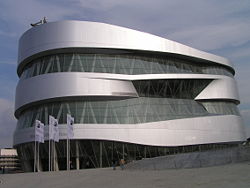
Stuttgart is home to Germany's ninth biggest exhibition centre, Stuttgart Trade Fair which lies on the city outskirts next to Stuttgart Airport. Hundreds of SMEs are still based in Stuttgart (the so-called " Mittelstand"), many still in family ownership with strong ties to the automotive, electronics, engineering and high-tech industry.
The cradle of the automobile
The motorbike and four-wheel automobile were invented in Stuttgart (by Gottlieb Daimler and Karl Benz; industrialised in 1887 by Gottlieb Daimler and Wilhelm Maybach at the Daimler Motoren Gesellschaft). As a result it is considered by many to be the starting point of the worldwide automotive industry and is sometimes referred to as "The cradle of the automobile". Mercedes-Benz, Porsche and Maybach are all produced in Stuttgart and nearby towns. The very first prototypes of the VW Beetle were manufactured in Stuttgart based on a design by Ferdinand Porsche.
Science and R&D
The region currently has Germany's highest density of scientific, academic and research organisations. No other region in Germany registers so many patents and designs as Stuttgart. Almost 45% of Baden-Württemberg scientists involved in R&D are based directly in the Swabian capital. More than 11% of all German R&D costs are invested in the Stuttgart Region (approximately 4.3 billion euros per year). In addition to several universities and colleges (e.g. University of Stuttgart, University of Hohenheim and several Stuttgart Universities of Applied Sciences), the area is home to six Fraunhofer institutes, four institutes of collaborative industrial research at local universities, two Max-Planck institutes and a major establishment of the German Aerospace Centre (DLR).
Financial services
The Stuttgart Stock Exchange is the second largest in Germany (after Frankfurt). Many leading companies in the financial services sector are headquartered in Stuttgart with around 100 credit institutes in total (e.g. LBBW Bank, Wüstenrot & Württembergische, Allianz Life Insurance).
A history of wine and beer
Wine-growing in the area goes back to 1108 when, according to State archives, Blaubeuren Abbey was given vineyards in Stuttgart as a gift from "Monk Ulrich". In the 17th century the city was the third largest German wine-growing community in the Holy Roman Empire. Wine remained Stuttgart's leading source of income well into the 19th century.
Stuttgart is still one of Germany's largest wine-growing cities, thanks in main to its location at the centre of the "Württemberg Wine Growing Area" (110.3 km², one of 13 official areas captured under German Wine law). The continuing importance of wine to the local economy is marked every year at the annual wine festival ("Weindorf").
Stuttgart also has several famous breweries such as Stuttgarter Hofbräu, Dinkelacker, and Schwaben Bräu.
Transport
Following the suit of other German cities such as Berlin, Cologne and Hanover, on 1 March 2008 a Low Emission Zone (LEZ) came into effect in Stuttgart with the aim of improving air quality. This affects all vehicles entering the Stuttgart "Environmental zone" (Umweltzone), including vehicles from abroad.
Local transport
Stuttgart has a light rail system known as the Stuttgart Stadtbahn. In the city centre and densely built-up areas, the Stadtbahn runs underground. Stations are signposted with a "U" symbol, which stands for Unabhaengig (independent). Until 2007, Stuttgart also operated regular trams. Stuttgart also has a large bus network. Stadtbahn lines and buses are operated by the Stuttgarter Straßenbahnen AG (SSB).
The outlying suburbs of Stuttgart and nearby towns are served by a suburban railway system called the Stuttgart S-Bahn, using tracks supplied by the national Deutsche Bahn AG (DBAG).
A peculiarity of Stuttgart is the Zahnradbahn, a rack railway that is powered by electricity and operates between Marienplatz in the Stuttgart South district of the city and Degerloch. It is the only urban rack railway in Germany. Stuttgart also has a Standseilbahn, a funicular railway that operates in the Heslach area of Stuttgart South and the forest cemetery (Waldfriedhof). In Killesberg Park, on a prominent hill overlooking the city, there is the miniature railway run by diesel (and on weekends with steam).
Rail links
Stuttgart is a hub in the InterCityExpress and InterCity networks of Deutsche Bahn AG (DBAG), with through services to most other major German cities. It also operates international services to Strasbourg, Vienna, Zurich and Paris (four times a day, journey time 3 hours 40 minutes).
Long distance trains stop at Stuttgart Hauptbahnhof, the city's main line terminus which is also used by regional DBAG RegionalExpress and RegionalBahn for services to stations in the Stuttgart metropolitan area. The local rail networks (see above) operate underneath the terminus.
Stuttgart also has its own rail freight centre with marshalling yards and a container terminal in the Obertürkheim area of Hedelfingen.
Air, road and waterway links
Stuttgart is served by Stuttgart Airport (German: Flughafen Stuttgart), an international airport approximately 8 miles (13 km) south of the city centre on land belonging to the neighbouring town of Leinfelden-Echterdingen. It takes 30 minutes to reach the airport from the city centre using S-Bahn lines S2 or S3. Stuttgart airport is Germany's only city airport with one runway. Despite protests and local initiatives, surveys are currently underway to assess the impact of a second runway.
The airport is adjacent to the A8 Autobahn, a major motorway which forms the southern boundary of Stuttgart and runs from Luxemburg via Saarbrücken, Karlsruhe, Stuttgart, Munich and Salzburg eventually to Vienna. Other Autobahns leading to Stuttgart are the A81 (Zürich – Singen – Würzburg – Hamburg) and A831.
Stuttgart has an inland port in Hedelfingen on the River Neckar.
The Stuttgart 21 project
After years of political fighting and controversy, plans were approved in October 2007 to convert the main train station to a through station. The Stuttgart 21 project will include the rebuilding of surface and underground lines connecting the station in Stuttgart’s enclosed central valley with existing railway and underground lines. Building work is scheduled to start in 2010 and should be completed in 2020.
Sport
Football
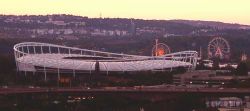
As in the rest of Germany, football is the most popular sport in Stuttgart which is home to "The Reds" and "The Blues". "The Reds", VfB Stuttgart, are the most famous and popular local club. An established team in the German Bundesliga, VfB was founded in 1893 and has won five German titles since 1950, mostly recently in 1992 and 2007. VfB is based at the Gottlieb-Daimler-Stadion in Bad Cannstatt.
"The Blues", Stuttgarter Kickers, are the second most important football team. They currently play in the Regionalliga Süd (third division) at the smaller Gazi Stadium close to the TV tower in Degerloch.
Other lower-division football teams are Sportfreunde Stuttgart - most famous for taking part in the Sir Thomas Lipton Trophy in 1908, considered the first World Cup - and FV Zuffenhausen.
Other sports
Stuttgart is home to VfL Pfullingen/Stuttgart, a local handball team that played in the national league from 2001 to 2006 in the Schleyerhalle. Its three-times German champion women's volleyball team, CJD Feuerbach, has now stopped playing for financial reasons but there is now Stuttgart Volleyball Club with a women's team in the 2nd southern league.
Stuttgart's ice hockey team, Stuttgarter EC plays at the Waldau ice rink in Degerloch. The strongest local water polo team is SV Cannstatt which won the German championship in 2006.
Stuttgart has two American Football teams, the Stuttgart Nighthawks American football team which plays in the Western Europe Pro League and Stuttgart Scorpions which plays in Stuttgarter Kickers' Gazi Stadium.
TC Weissenhof is a Stuttgart-based women's tennis team that has won the German championship four times. Another women's team is TEC Waldau Stuttgart (German champions in 2006).
HTC Stuttgarter Kickers is one of the most successful field hockey clubs in Germany, having won the German championship in 2005 and a European title in 2006.
Sporting events
Stuttgart has a reputation for staging major events, including the 1993 World Championships in Athletics. It was one of the twelve host cities of the FIFA World Cup 2006. Six matches, three of them secound round matches, including the 3rd and 4th place playoff, were played at the Daimler Stadium. Stuttgart was also 2007 "European Capital of Sports", hosting events such as the UCI World Cycling Championships Road Race and the IAAF World Athletics Final.
Other famous sports venues are the Weissenhof tennis courts, where the annual Mercedes Cup tennis tournament is played, the Porsche Arena (hosting tennis, basketball and handball) and the Schleyerhalle ( boxing, equestrianism/ show jumping, gymnastics, track cycling etc).
Sister cities
Stuttgart is official twin towns with the following cities:
|
The city has "special friendships" with the following cities:
 Ōgaki, Gifu Prefecture, Japan, since 1988
Ōgaki, Gifu Prefecture, Japan, since 1988 Shavei Zion, Israel
Shavei Zion, Israel Nanjing, People's Republic of China
Nanjing, People's Republic of China
Notable residents
Notable people born in Stuttgart or residents who influenced the history of the city:
- Rosalie Abella - Justice, Supreme Court of Canada
- Günther Behnisch - architect
- Robert Bosch - inventor (founded the Robert Bosch GmbH)
- Gottlieb Daimler - inventor of the motorbike and automobile, founded what would become Mercedes-Benz
- Roland Emmerich - film producer, director and writer
- Gerhard Ertl - Nobel Prize laureate in chemistry 2007
- Sascha Gerstner-Guitarist of German power metal band Helloween
- Bernd Glemser - international concert pianist
- Georg Wilhelm Friedrich Hegel - philosopher
- Theodor Heuss - First German Post-War President
- Jürgen Klinsmann - football player, former coach of the German football squad
- Helmut Lachenmann - composer
- Mark Landler - New York Times European economic correspondent
- Hermann Lang - Grand Prix race car driver
- Fritz Leonhardt - structural engineer
- Wilhelm Maybach - inventor together with Gottlieb Daimler
- Frei Otto - architect (designer of the roof on the Olympic stadium in Munich)
- Ferdinand Porsche - creator of the VW Beetle, founder of the Porsche car company
- Manfred Rommel - Mayor of Stuttgart 1974-1996, son of Erwin Rommel
- Friedrich von Schiller - famous German poet
- Peter Schilling - popular musician and Neue Deutsche Welle artist
- Claus Schenk Graf von Stauffenberg - member of the German Resistance who tried to kill Hitler
- Bernard Tomic - Tennis child prodigy
- Dorothea Wendling - soprano for whom the role of Ilia was created by Mozart in his Idomeneo
- Richard von Weizsäcker - German President, Mayor of Berlin
- The Medic - From Team Fortress 2
Trivia and interesting facts
The logo of automobile company Porsche holds a modified version of Stuttgart's coat of arms at its centre.
Stuttgart is home to several installations of the United States Armed Forces:
- Robinson Barracks in the Burgholzhof area of Stuttgart
- Kelley Barracks in the district of Möhringen
- Patch Barracks in the district of Vaihingen (home to the United States European Command (EUCOM), the only Unified Combatant Command outside the United States)
